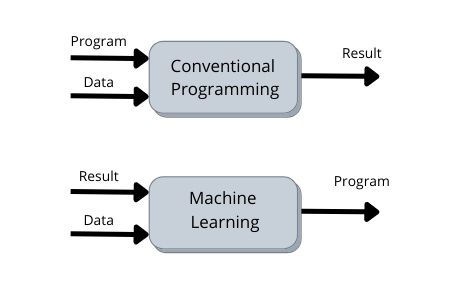There are many applications for machine learning in our daily activities. Each one of them has its advantage and disadvantage. Today, let us look at both the pros and cons of machine learning.
Before getting into the pros and cons, let us understand what machine learning is.
What Is Machine Learning?
Machine learning is a field of computer science that works on algorithms that improve based on experience. It provides solutions for problems that conventional programming cannot.
Let us first understand machine learning using a simple analogy. Take a student who decides to learn a new topic that he has no idea about. He starts to read a book on that topic.
At the start, he does not understand the concepts fully. But as he reads and practices the problems more and more, he gets experienced in the topic and gains knowledge of it. Here the book is a dataset, the student is the model, and the knowledge he gained is experience.
Difference Between Conventional Programming and Machine Learning

| Conventional Programming | Machine Learning |
|---|---|
| Conventional programming works on a simple logic like an if-else condition. It cannot handle variations in data. | Machine learning is more technical. The programmer needs to work on which algorithm works better, which parameter suits you well, how to handle missing data, how to handle noises, etc. |
| In conventional programming, the logic and data are given as inputs to the system, and the result is generated. | In machine learning, a set of input and output data is fed as input, and the logic is generated as output. With this logic generated, any new input is given, and the model tries to predict the output. |
Now, let us see the pros and cons of machine learning. I have done some research on this topic, and here are all the important points that I found. Let’s check them out.
Pros of Machine Learning
- Unlike conventional programming, where the coder has to improve the algorithm on his own, machine learning allows the model to learn, predict and improve over time.
- Automation reduces workload and time consumption taken by the human workforce. With the introduction of machine learning to industries, the works that cannot be automated by conventional programming can be automated now.
- Companies and individuals use machine learning from the user data to derive knowledge and even solutions to the problems with ease. For example, Instagram recommends posts related to the posts liked by the users. Instagram sets up advertisements related to the posts we like or stories we put.
- Trends and patterns recognition are important factors for companies to make profits. For example, companies can figure out which product sells the most, which product does not sell well, which combination of products customers buy, etc. These questions can be answered using machine learning.
- Machine learning can handle multidimensional and multi-variety data even in uncertain environments.
- Machine learning can handle noises in data. Even if some of the data is incorrect or invalid, machine learning has the power to handle this issue and provide an efficient solution.
- Machine learning can handle missing values. Even if some columns of the data are missing at random, machine learning can handle it and provide the solution.
- The Internet is full of threats, attacks, and hackers trying to breach the security and privacy of users. Security systems built upon machine learning improve the privacy and security of the organization’s site, data, etc. Even when the security fails, the models learn from it and prevent it in the next attack.
- Machine learning has a lot of applications in the real world, from simple spam detection to self-driving cars. Machine learning is applied in healthcare, fraud detection, future prediction, recommendation systems, speech recognition, etc.
Cons of Machine Learning
- Machine learning requires a large amount of data for the model to train and predict. At the same time, the data should not be inconsistent, imbalanced, or contain noise at large. Yes, machine learning can handle a little noise or missing values, but when it happens on a large scale, it might lead to low accuracy scores, which lead to incorrect results.
- Data privacy is one of the biggest concerns in the data science industry. Most of the data big companies take from users is taken without explicitly telling them. Both companies and users should come to a middle ground to benefit both parties.
- High CPU/GPU-powered machines need to be bought by companies to gain knowledge from their databases. Models take high CPU/GPU power to train large datasets.
- Apart from power consumption, these machines are expensive to purchase and maintain. It makes it difficult for normal people to access these technologies.
- Machine learning can use different algorithms to predict the result. The programmer has to manually try out different algorithms for the data and figure out which gives the best result. This process is a time taking and resource-consuming job.
- Each algorithm has its parameters that need to be tuned according to the data we collect and the result we want to achieve. After finding the perfect algorithm, each algorithm has to be tuned accordingly to get the best results. This process is also time taking and resource-consuming job.
- The unpredictability of errors is one of the biggest disadvantages of machine learning compared to conventional programming. You will never know when the model will give you an incorrect result. In conventional programming, we can traceback where the error takes place. But this is very difficult in machine learning.
Since the technology is new and growing, these disadvantages will be compromised as time passes.
Final Thoughts
I hope you understood the main pros and cons of machine learning. If you know any advantages or disadvantages of machine learning that I did not mention, feel free to comment below. I will add your valuable points to this article.

